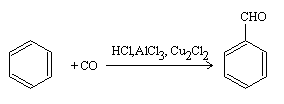What is Gattermann-Koch formylation?
Gattermann-Koch formylation is a process in which benzene, alkylbenzenes, or polycyclic aromatic hydrocarbons are formylated with carbon monoxide, CO, and hydrogen chloride, HCl, in the presence of aluminum chloride, AlCl3, under high pressure. The introduction of cuprous chloride, Cu2Cl2, enables the reaction to occur under atmospheric pressure.

References
- Gattermann, L. and Koch, J.A. (1897), Eine Synthese aromatischer Aldehyde. [A synthesis of aromatic aldehydes.] Ber. Dtsch. Chem. Ges., 30: 1622-1624. https://doi.org/10.1002/cber.18970300288
- Gattermann, L. (1906), Synthesen aromatischer Aldehyde. [Syntheses of aromatic aldehydes.] Justus Liebigs Ann. Chem., 347: 347-386. https://doi.org/10.1002/jlac.19063470306
Full Professor of Organic Chemistry at the University of Granada, with a long-standing research career in Computational Chemistry and molecular modeling and design.